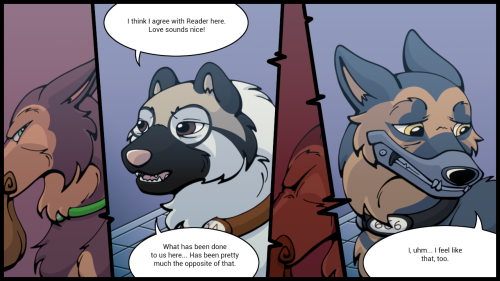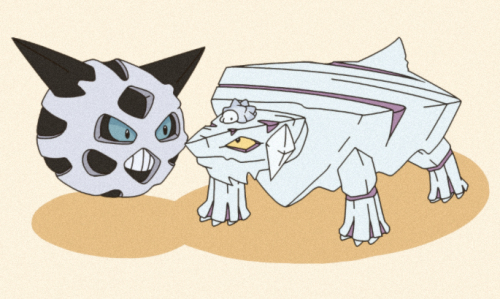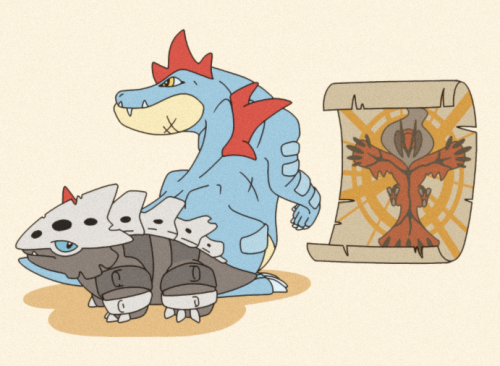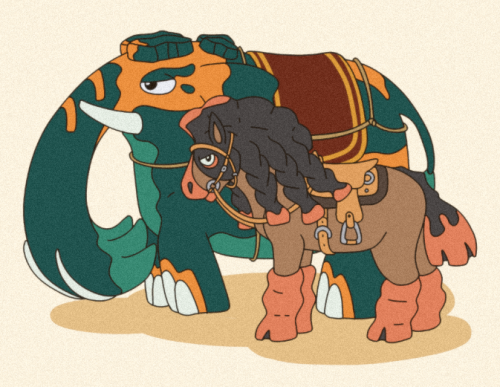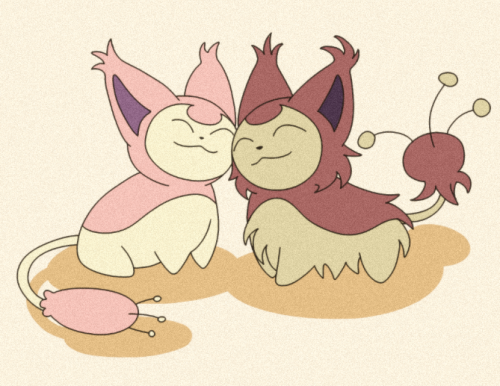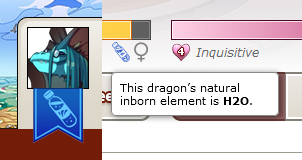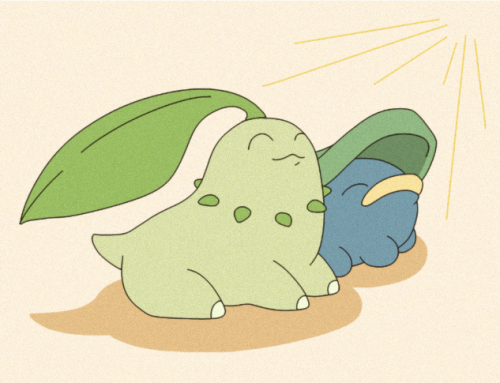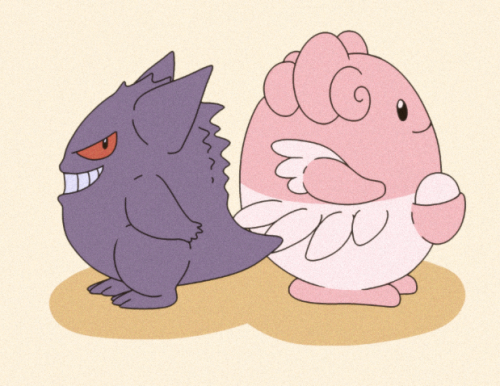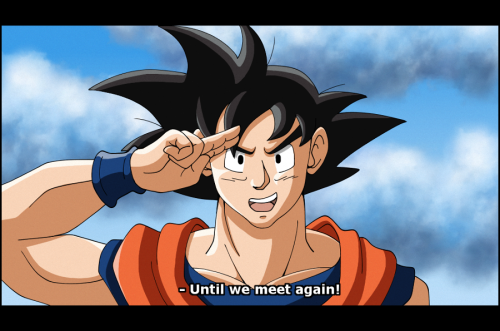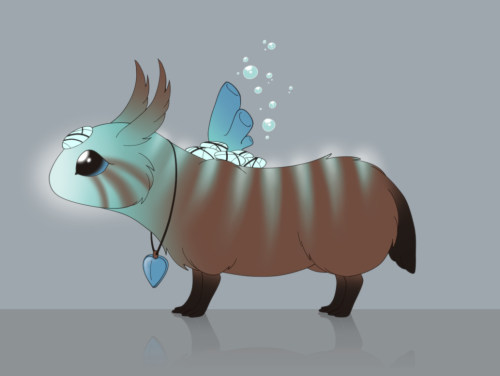The last of Mundane Pokémon questions people have asked recently
My brother was curious to hear how ice type Pokémon work in this setting.
I haven’t talked about them much so far because the answer might sound a bit boring: the “superpower” of ice types is simply surviving and thriving in cold environments. In reality that is definitely demanding enough, but yeah, it isn’t nearly as flashy as bursting out flames or floating in the air. Their bodies aren’t made out of ice or snow, they simply look the way they do in order to camouflage into their environment, and they don’t really shoot ice out of their mouths either. Though a select few, like the tiny Snom, can spit out acid that in cold air feels like it’s freezing your skin.
Ice type Pokémon can also be a rather depressing subject to talk about because of how badly they are affected by climate change. Their living environment is currently shrinking faster than most of the Pokémon can adapt to, which means that at least some of them are going to become extinct in the future. Some will likely survive in captivity and some might crossbreed with their non-icy relatives to let at least their genes survive on, even if their species itself disappears. Some, like for example Cryogonal, are however so higly specialized to cold that things are looking very grim for them.
He also wanted to know if there are “evil teams” like Team Rocket in Mundane and if yes, what are they like.
Pretty much all of the evil teams of the game series are based on real life in Mundane, but most of them don’t have much to do with Pokémon. Team Yell are based on your average annoying football hooligans, Team Star and Team Skull are based on youth gangs that vary from rather benign to actually dangerous etc. They don’t really use Pokémon more than their irl counterparts would use animals.
Then there’s Teams Rocket, Plasma and the group of Magma, Aqua and Galactic. The latter three are based on fanatic religious groups that worship certain Pokémon. These Pokémon are usually legendaries and mythicals, meaning there’s no scientific proof of them existing, but these groups do still believe in them. They don’t usually cause harm for Pokémon, but they can for sure be detrimental for the people who get lured into their ranks.
What Team Plasma pretends to be like in the beginning of B/W games is based on extremist groups that think Pokémon should not be living together with humans, not for food production nor for companionship. They see their own actions as something that protects Pokémon, but in reality their means cause much harm for both people and the Pokémon they claim to help.
And lastly Team Rocket is based on wealthy, influential orginized crime groups like mafia. In some places these people are basically above the law and can therefore keep Pokémon that no normal person should ever have, usually for clout. These Pokémon are often aggressive, large and/or rare and they are rarely kept in appropriate ways, causing them sickness and suffering. Sometimes the Pokémon do also escape, which can end badly for both the Pokémon and humans unfortunate enough to come across them.
Mundane Pokémon time!
There was a question about what would happen if a Pokémon changed its evolution in the middle of the process or stopped evolving completely. How would it work or is it even possible?
Changing the evolution from one Pokémon to another is mostly rare. 90 % of the time it’s seen in pet Eevee lines, but it can technically happen for Pokémon like Poliwhirl, too, if it’s in the middle of becoming a Politoed and someone adds Water Stone into its diet. More often than not the traits of the lost evolution disappear over time, but sometimes Pokémon can retain traits from both of the evolutionary lines it was going towards. This is usually not great for the Pokémon and it can mess with its social status and even internal biology in unpredictable ways.
Stopping evolution on the other hand is much more common, at least for pets. This is done by adding Everstone into their diet. In some parts of the world this is a standard procedure that almost everyone does, comparable to neutering. It’s recommended that Everstone is introduced to the diet well in advance before the possible evolution process starts, but there can definitely be accidents that make the precaution fail: maybe the dose was too low, maybe the Pokémon secretly spat the mineral out, maybe the mineral wasn’t used regularly enough etc. If the Pokémon then starts evolving but is stopped in the middle of it, it can retain some of the traits it already developed instead of reverting fully back to its old form.
Another question was about how common is riding Pokémon and if it requires special permissions and/or laws.
This varies wildly from one country to another. In western world riding is mostly a hobby and sport and nowadays rarely used as a major way of transportation. In countries where motorized vehicles aren’t as common or accessible or the terrain is very extreme, riding Pokémon is still used more in day to day life. There aren’t usually that many laws about riding or any sort of riding licenses, as laws usually focus more on overall welfare of the Pokémon and not just the aspect of riding. If you ride on the road you of course have to follow general traffic rules though.
As sad as it is, there are no flying Pokémon that humans could ride while they are in the air. Also most Pokémon big enough to carry humans have not been domesticated to do so; there’s always that one person who has tamed a Torterra or a Garganacl or whatever and who hangs on the Pokémon’s back while they move around, but that’s not really proper riding let alone a safe thing to do. Mostly people ride appropriately sized horse, bull, goat and sheep Pokémon. Some of the more uncommon rides include Copperajah and Camerupt, while Stantler and Arcanine are downright rare but not unheard of. Some establishments even let you ride a Lapras, but that’s pretty controversial and not really supported by Pokémon welfare groups.
This time in Mundane Pokémon we have a couple of individual species introductions.
In the world of Mundane, Skitty is one of the most popular Pokémon to be kept as a pet. It’s cute, playful, rather small and doesn’t have any wild elemental powers, so it’s very safe to keep it in an average household and even around children. It also has one huge advantage over many other cat-like Pokémon: Skitty requires moon stone to evolve, so it stays in its base form unless the mineral is deliberately added to its diet.
Pet Skitty has all sort of variations, from many different color morphs to long or curly haired ones. In the wild it is a fairly adaptable species that can live both on its own and in loose colonies. It’s a carnivore that stalks pretty much anything small enough to be taken down and eaten by it. Skitty also sometimes utilize a strategy where it uses its tail as a bait, trying to lure especially bug Pokémon to land on the tail’s flower-like tip, only to be snatched up by the hungry kitten.
On the other hand Jynx line is rare, elusive and poorly known. It lives in cold regions and rarely comes in contact with humans. It’s solitary and seems to eat pretty much anything from plants to carcasses, hunting actively only when there’s no other food source available. While hunting Jynx uses the psychic power of suggestion: Jynx itself hides away and then makes its target think it wants to get closer to its hiding place. The power isn’t strong enough to override anyone’s own reasoning if they notice that they are in danger, but as long as they don’t notice Jynx’s presence, the thoughts inserted into their mind feel completely harmless. The power can also be used to achieve the opposite result, making unwanted visitors want to leave Jynx’s territory behind as soon as possible.
Aside from their psychic abilities, the most notable thing about the species is that every Jynx and its pre-evolution Smoochum seems to be female. Because of their solitary lifestyle and deserted living environment the species developed an alternative reproducion strategy to support them if they couldn’t find a mate: parthenogenesis. That basically means that females can lay fertilized eggs that are more or less the mother’s clones. Then, for reasons not really known, over time male Jynx disappeared completely. It’s theorized that relying solely on parthenogenesis has lessened gene variation of the species quite a lot, which is likely one of the main reasons for its current rarity. It might even lead to its extinction… If climate change doesn’t do it first.
Another year, another collection on April Fools’ shenanigans! Tumblr’s booping system is easily the most fun site-wide prank this time around, it’s been stupidly endearing to just throw boops at random strangers and mutuals alike. Flight Rising’s renamed flights/elements and dA’s new branding are not much to write home about, but then again TWWM’s Ikkit takeover has been also very amusing thing to witness.
Mundane Pokémon continues once again!
One of the questions I got was about grass Pokémon: are they animals, plants or something else?
All Pokémon recognized by science are animals. In real world there are some examples of animals that can utilize bacteria to create bioluminescence, algae to photosynthesize or even live in mutualistic relationships with fungi; in Mundane these sort of relationships started to develop very early on and have spread far and wide in the tree of life. Grass Pokémon are one of the most numerous examples of this development.
Usually grass Pokémon can and will eat normally while using their photosynthesizing parts (that often look like plants due to convergent evolution and/or camouflage) to supplement their diet as well as aid them in times of scarce food. Some, like Sunkern and Cherubi, lean more heavily into the consumption of sunlight while some others, like Rowlet, barely do any photosynthesizing at all.
Despite how they look and are utilized, the plant-like Pokémon parts are not vegetables. They are integral parts of the Pokémon’s body and usually can’t be removed willy nilly without causing problems, pain or at least discomfort to the Pokémon. Eating them is also definitely not vegan.
People were also curious to see what do some heavily domesticated Pokémon species look like and how wild can their appearances get.
My answer to this one might be a bit boring, as it’s basically “if someone has bred it in real life, someone has bred it in Mundane”. The most domesticated Pokémon lines are those that have benefitted the humankind in some way in pre-industrial era, like beasts of burden, steeds, livestock, hunters etc.
The biggest difference is that in Mundane there isn’t really a single species as insanely varied as dogs of the real world. That’s because instead of only one species there are several domesticated dog-like Pokémon lines, so there was never need to modify any single one to such extent. For example Lycanrock is often used as a hunting companion, Stoutland as a herder and Furfrou as a guard dog. All of them definitely have color variations and people who use them in unconventional ways, but there’s really no hairless toy Arcanine or huge mastiff Yamper.
I got some questions about Mundane Pokémon in an art Discord server, so let’s dive into the first couple of the topics that were brought up!
The first thing people were wondering about was how does friendship evolution work in this setting? And I myself decided to talk about it together with trade evolution, because the answer to both happen to be the same: it’s not actually known how they work! Scientifically at least.
Traditionally they have been believed to be two sides of the same coin, friendship evolution process starting when the living conditions of the Pokémon are stable and favorable enough and trade evolution happening when the Pokémon goes through extraordinary hardships but survives and comes out stronger from the experience. Modern science does know that both processes start due to hormonal cues, but like I said before, it’s not yet well understood what triggers those hormonal changes in the first place. They do not seem to be tied to age or social status of the Pokémon the way level up evolution is and they do not require ingestion of minerals like stone evolutions do. Scientist continue to investigate the matter, but considering especially what the triggers of trade evolution are traditionally thought to be, it’s not an easy subject to study ethically.
The second question was how does Eevee and its many evolution paths work.
This one has a rather simple answer: all of the different evolutionary forms are actually regional variants. Eevee populations that have lived for many generations in cold climate have evolved (Darwinially) to evolve into Glaceon, Eevee who have adapted into nocturnal lifestyle evolve into Umbreon and so on. These separate populations are normally capable only taking the one evolutionary path they have adapted to, but here’s where things get a bit messy…
The thing is all of the Eevee lines are capable of crossbreeding with each other. In nature it happens only occasionally, but Eevee has been a popular pet for centuries if not millennia and in the past some people started delibiretaly trying to breed Eevee that are capable of taking any evolutionary path its owner chooses.
Nowadays there are pretty much two schools of Eevee breeders: those who think the population lines should be kept separate because that’s the way it is in the nature, and those who think that every pet Eevee should be able to evolve into any form its owner wants to. Both sides have their pros and cons: multi evolution line Eevee tend to face problems while evolving much more often than their natural counterparts, but single evolution lines suffer from too narrow gene pools. That’s because most of the pet Eevee are multi evolutionary at least to some extent, while wild Eevee populations are nowadays endangered.
In their yearly visit to the Conservatory room of the spiral stones, Song decided to hold a nightly concert for some Esk.
I’m not the greatest fan of how this came out, but eh, at least I got to donate some points to the Wellsprings.
I was going to make a compilation of new and old Dragon Ball art and ramble about the grief of hearing about the sudden death of Akira Toriyama… But the universe decided that this shall be A Shit Day in every way possible way and completely break Imgur where I store my image files. Aaaaand now I’m too tired and stressed out to really do more than go to bed and play video games, so I’ll just repost this one more or less fitting Goku from a few years ago.
Rest in piece, Toriyama! Thank you for all of your wonderful stories!

